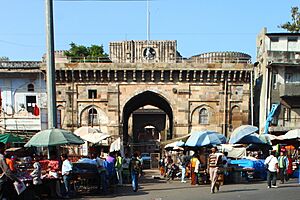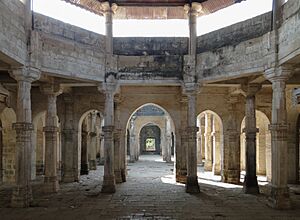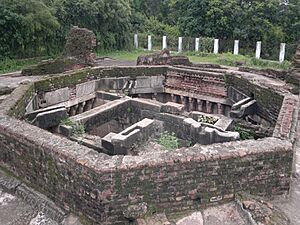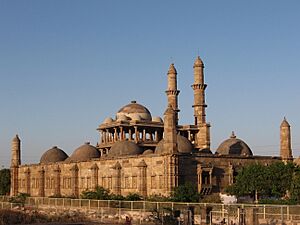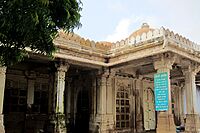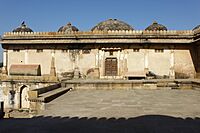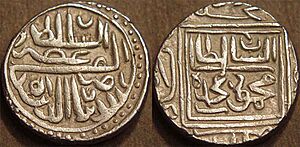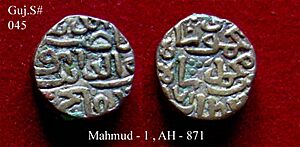Mahmud Begada facts for kids
Quick facts for kids Mahmud Shah I |
|||||
|---|---|---|---|---|---|
| 7th Sultan of Gujarat | |||||
| Reign | 25 May 1458 – 23 November 1511 | ||||
| Predecessor | Daud Shah | ||||
| Successor | Muzaffar Shah II | ||||
| Born | 1445 Ahmedabad |
||||
| Died | 23 November 1511 Ahmedabad |
||||
| Burial | Sarkhej Roza, Ahmedabad | ||||
| Spouse | Rupamanjhari, Hirabai | ||||
| Issue | Khalíl Khán (Muzaffar Shah II) Muhammad Kála Ápá Khán Áhmed Khán |
||||
|
|||||
| Dynasty | Muzaffarid dynasty of Gujarat | ||||
| Father | Muhammad Shah II | ||||
| Mother | Bíbi Mughli | ||||
| Religion | Sunni Islam | ||||
Mahmud Begada, also known as Mahmud Shah I, was a very important ruler (Sultan) of the Gujarat Sultanate. He ruled for a long time, from 1458 to 1511. He became king when he was quite young. He was famous for capturing two strong forts, Pavagadh and Junagadh. These victories earned him the nickname Begada, which means "conqueror of two forts." He also made Champaner his new capital city.
Contents
Understanding Mahmud Begada's Names
Mahmud Begada had a long full name: Abu'l Fath Nasir-ud-Din Mahmud Shah I. When he was born, his name was Fat'h Khan or Fateh Khan. He also called himself Sultân al-Barr, Sultân al-Bahr, which means "Sultan of the Land, Sultan of the Sea." This showed his power over both land and sea.
His nickname, Begada or Begarha, has two main explanations:
- Some say it came from his large, twisted mustaches, which looked like a bullock's horn. A bullock with such horns was called "Begado."
- The more common reason is that the word comes from the Gujarati words be (meaning "two") and gadh (meaning "fort"). People gave him this title because he successfully captured two major forts: Junagadh (near Girnar) in 1472 and Pavagadh (near Champaner) in 1484.
Mahmud Begada's Early Life
After the death of Sultan Ahmad Shah II, the nobles chose his uncle, Dáúd Khan, to be the next ruler. However, Dáúd Khan made some unpopular decisions, like giving important jobs to people who were not noble. Because of this, he was removed from power very quickly, after only a few weeks.
In 1459, Fateh Khan, who was just over thirteen years old, became the new Sultan. He was the son of Muhammad Shah II and Bíbi Mughli. He took the title of Mahmud Shah I. Fateh Khan had a close connection with a respected saint named Sháh Álam. Stories say that the saint helped protect young Fateh Khan from dangers, even making him appear as a girl to avoid capture by his enemies.
Mahmud Begada's Reign
Starting as Sultan
Soon after Mahmud became Sultan, his uncle Dáúd Khan passed away. Some powerful nobles tried to trick the young Sultan. They told him that his chief minister, Shaâbán Imád-ul-Mulk, was planning to betray him. They had the minister arrested and held in the Bhadra Fort.
However, the chief of the elephant stables, Abdulláh, told the young Sultan that the nobles were the real traitors. He said they wanted to put Mahmud's uncle, Habíb Khán, on the throne instead. Mahmud, being very clever, listened to his mother and loyal friends.
The next morning, Mahmud ordered all his elephants to be prepared for battle. He sat on his throne and pretended to be angry, demanding that Imád-ul-Mulk be brought to him. When his orders were not followed, he went to the fort himself and freed his minister. Some of the rebel nobles' guards joined Mahmud, while others ran away.
When the rebellious nobles heard what happened, they marched against the Sultan. Many people advised Mahmud to escape the city and gather an army. But the young Sultan was brave. He ordered Abdulláh to charge the nobles with his 600 elephants. The elephants scattered the rebels, who fled or hid. Some were killed, and one was pardoned. This event showed Mahmud's strong leadership from a very young age.
Helping the Bahmani Sultanate
In 1461 or 1462, the Sultan of the Bahmani Sultanate, Nizam Shah Bahmani, asked Mahmud Shah for help. His country was being attacked by Sultan Mahmud Khilji of the Malwa Sultanate. Mahmud Shah quickly went to help. When Mahmud Khilji heard that the Gujarat army was coming, he retreated, losing many men from thirst and attacks by local tribes. Mahmud Shah returned to Gujarat after helping his ally.
In 1462, Mahmud Khilji attacked the Deccan region again. Once more, the Bahmani Sultan asked Mahmud Shah for help. Mahmud Khilji retreated again when he heard of Mahmud's approach. Mahmud Shah then warned the Malwa Sultan to stop bothering the Deccan region, threatening to attack his capital, Mandu, if he continued.
Mahmud Shah also fought against pirate chiefs who lived in the hills and near the coast. He captured their fort and made them pay a yearly tax.
Conquering Junagadh and Girnar
Mahmud Shah then decided to conquer the strong mountain fort of Uparkot on Girnar hill, near Junagadh in the Saurashtra region.
- In 1467, he attacked Junagadh. The local ruler, Ra Mandalika III, surrendered, and Mahmud returned to his capital.
- The next year, Mahmud heard that the Junagadh ruler was still acting like a king, using a golden umbrella. Mahmud sent an army, and the ruler sent the umbrella and gifts to the Sultan.
- In 1469, Mahmud sent another army to attack the region, planning to fully conquer Junagadh and Girnar. The ruler, Ra Mandalika, met Mahmud and asked why the Sultan wanted to destroy him. Mahmud replied that not following Islam was a serious fault and ordered the ruler to convert.
- The ruler was scared and fled into the Girnar fort. After a siege of almost two years, in 1472–73, the ruler ran out of supplies. He surrendered the fort and converted to Islam. His life was spared, but the region of Sorath (where Junagadh is) became part of Mahmud's kingdom.
After the war, in 1479, Mahmud Shah repaired the outer wall of Junagadh city. He loved the area's beauty and encouraged scholars and nobles to settle there. He built a palace and made Junagadh his new capital, renaming it Mustafábad. He made sure all the local chiefs paid tribute to him.
Taking Champaner and Pavagadh
In 1479, Mahmud Shah sent an army to attack Champaner, which was ruled by the Khichi Chauhan Rajputs. Around this time, he also founded the city of Mehmúdábád (now Mahemdavad) because the area was troubled by robbers. Several buildings in Mahemdavad, like the Bhammariyo Kuvo (a well) and Chanda-Suraj No Mehal (a palace), are linked to him.
In 1482, there was a shortage of food in Gujarat, but the Champaner area had enough. A local commander from Mahmud's side raided the Champaner border. In response, the Champaner ruler attacked the commander, defeating him and capturing elephants and horses.
When Mahmud Shah heard this, he marched with a large army towards Vadodara. The Champaner ruler, Raval, became worried and asked for peace. But Mahmud refused, saying, "Only the sword and the dagger will speak between us."
The Raval prepared for a strong fight and asked Ghiás-ud-dín Khilji of the Malwa Sultanate for help. To stop them from joining forces, Mahmud Shah left his nobles to continue the siege of Champaner and marched to Dahod. Sultan Ghiás-ud-dín then retreated.
Upon returning, Mahmud began building a grand Jáma Mosque at Chámpáner. This showed he would not leave until he captured the hill-fort of Pavagadh. The siege lasted over twenty months (April 1483–December 1484). Mahmud's soldiers noticed that the Raval's soldiers often left their posts for bathing in the mornings. They planned a morning attack and captured the first gate. Then, Malik Ayáz Sultáni found a weak spot, broke through, and captured the main gate.
The Raval and his Rajput warriors fought bravely but were defeated. The Raval and his minister were wounded and captured. They refused to convert to Islam and were put to death. Pavagadh was conquered on November 21, 1484. The Raval's son later converted to Islam and became a noble in the future.
After capturing Pávágaḍh, Mahmud Shah built a wall around Champaner and made it his capital, renaming it Muhammadábád. He ordered the area to be filled with fruit trees and beautiful gardens. It took 23 years to build the new city. The city was later conquered by the Mughal Empire in 1535.
The magnificent Jama Mosque in Champaner is considered one of the most beautiful buildings in Gujarat. It is a huge structure with two tall minarets (30 meters high), 172 pillars, and seven prayer niches. The central dome and carved gates are very impressive. Other structures in Champaner from Mahmud Begada's time include the Kevada Masjid, Citadel Jahanpanah, and Nagina Masjid. The Champaner-Pavagadh Archaeological Park is now a World Heritage Site.
Later Years and Battles with the Portuguese
In 1494–95, Mahmud went to fight Bahádur Khán Gíláni, a ruler who was attacking Gujarat's ports from Goa. Mahmud had previously warned him by attacking Mahim island (now in Mumbai) with 20 ships. This time, Mahmud sent an army by land and 300 boats by sea to attack Dabhol. The Bahmani Sultan, fearing Mahmud's power, captured Bahádur Khán and sent his head to Mahmud, who then returned home.
In 1499–1500, Mahmud prepared to attack Násir-ud-dín of Malwa, who had killed his own father to become king. But Násir-ud-dín showed great respect, and Mahmud decided not to attack. The next seven years were peaceful.
Battles with the Portuguese
Cambay (now Khambhat) was a very important port for trade between the Red Sea, Egypt, and Malacca. Traders from Gujarat were key in bringing spices from the Maluku Islands and silk from China.
The Portuguese had arrived in India and were becoming powerful in the Arabian Sea. Mahmud Begada joined forces with the Zamorin of Calicut to fight the Portuguese. He also asked his trading partners, the Egyptian Mamluks, for help.
In 1508, near Daman, Mahmud heard about a victory. The Gujarat fleet, led by Malik Ayyaz, along with the Egyptian fleet, had defeated the Portuguese in the Battle of Chaul.
However, in 1509, a major naval battle took place near Diu. This was the Battle of Diu. The Portuguese Empire fought against a combined fleet from the Gujarat Sultanate (under Malik Ayyaz), the Egyptian Mamluks, the Zamorin of Calicut, and even some support from the Ottoman Empire and European cities like Venice. The Portuguese won this battle. This event marked the beginning of European colonialism in Asia.
Mahmud Begada's Death
Mahmud Begada stayed in his capital from 1508 until his death in December 1511. He was 66 years old and had ruled for 54 years. Mahmud was buried at Sarkhej Roza near Ahmedabad. After his death, he was given the title Khúdáigán-i-Halím, meaning "the Meek Lord."
Just before he died, Mahmud was told that the Persian ruler, Sháh Ismáil Safawi, had sent an embassy. Because these envoys were known to be Shia Muslims, and Mahmud was a strong Sunni Muslim, he prayed that he would not have to see a Shia's face in his last days. His prayer was answered, as he died before the Persian embassy entered the city.
During his last days, a preacher named Sayed Muhammad of Jaunpur, who claimed to be the Mahdi (a spiritual leader), came to Ahmedabad. His speeches were very powerful, and he gained many followers. Mahmud's ministers advised him not to meet the preacher.
Mahmud Begada's Administration
Mahmud Begada was known for his strong religious beliefs, his fairness, his bravery, and his wise decisions. These qualities made him one of the greatest Gujarat kings.
One of his important rules was to continue giving land grants to the sons of landholders. If there was no son, half of the land grant would go to the daughter. He had a firm policy of not taking land from its owner unless they were proven to be unfair or greedy. This policy led to great wealth, and the government's income increased significantly.
The roads became safe from robbers, and trade was secure. He also had a rule that soldiers could not borrow money with interest. A special officer was appointed to lend money to soldiers who needed it, and they would repay it from their wages in small amounts. Mahmud also paid a lot of attention to growing fruit trees.
There is a story about how Mahmud ensured justice. Some merchants from Iraq and Khurásán were robbed in the Sirohi area. The king made them write down the value of their goods. He paid them from his own treasury and then recovered the money from the Rája of Sirohi.
Important Nobles in Mahmud Begada's Court
Mahmud Begada's court had many respected and generous nobles. They competed with each other in doing good deeds. Here are some of the most famous:
- Dáwar-ul-Mulk: He was a very fair administrator. His lands became so prosperous that even princes wanted them. He helped spread Islam in the Kathiawad region.
- Malik Ayáz: He was the governor of Diu. He built a strong fortress there, which the Portuguese later rebuilt. He also built a tower in the sea and stretched a huge iron chain across the harbor entrance to protect it.
- Khudáwand Khán Ālím: He founded a suburb south of Ahmedabad called Ālímpura, where he built a beautiful mosque. He also brought the cultivation of melons, figs, and sugarcane to Gujarat from Bijapur.
- Imád-ul-Mulk Āsas: He founded Isanpur, another suburb of Ahmedabad, and planted many fruit trees along the roads.
- Tájkhán Sálár: He was so well-liked by other nobles that after he died, no one wanted to take his title.
- Malik Sárang Kiwám-ul-Mulk: He was a Rajput by birth and founded the suburb of Sarangpur east of Ahmedabad, where he built a mosque.
- Aâzam and Moâzzam: These two brothers built a water tank, a mosque, and their own tomb between Vasna and Sarkhej.
Mahmud Begada's Family
Besides Khalíl Khán, who became Sultan after him, Mahmud had three other sons: Muhammad Kála, Ápá Khán, and Áhmed Khán.
- Muhammad Kála died during his father's lifetime, as did his mother, Ráni Rúp Manjhri. She was buried in Mánek Chowk in Ahmedabad.
- Ápá Khán was caught doing something wrong in a noble's private area, and the Sultan ordered him to be poisoned.
- Áhmed Khán was the son whom Khudáwand Khán tried to make king during Mahmud's lifetime, but the plot was stopped.
Mahmud Begada in Culture
Some European travelers spread interesting stories about Mahmud Begada. One popular tale said that he was given small amounts of poison from childhood. This made him immune to poisons and even made his body poisonous to others. This story inspired the English writer Samuel Butler to write lines about "The Prince of Cambay's daily food/ Is asp and basilisk and toad."
There are also many stories about his huge appetite, which even modern historians mention. For example, it is said that Mahmud ate a lot of food during the day, and his servants would keep meat patties (samosas) by his bed at night in case he got hungry.


